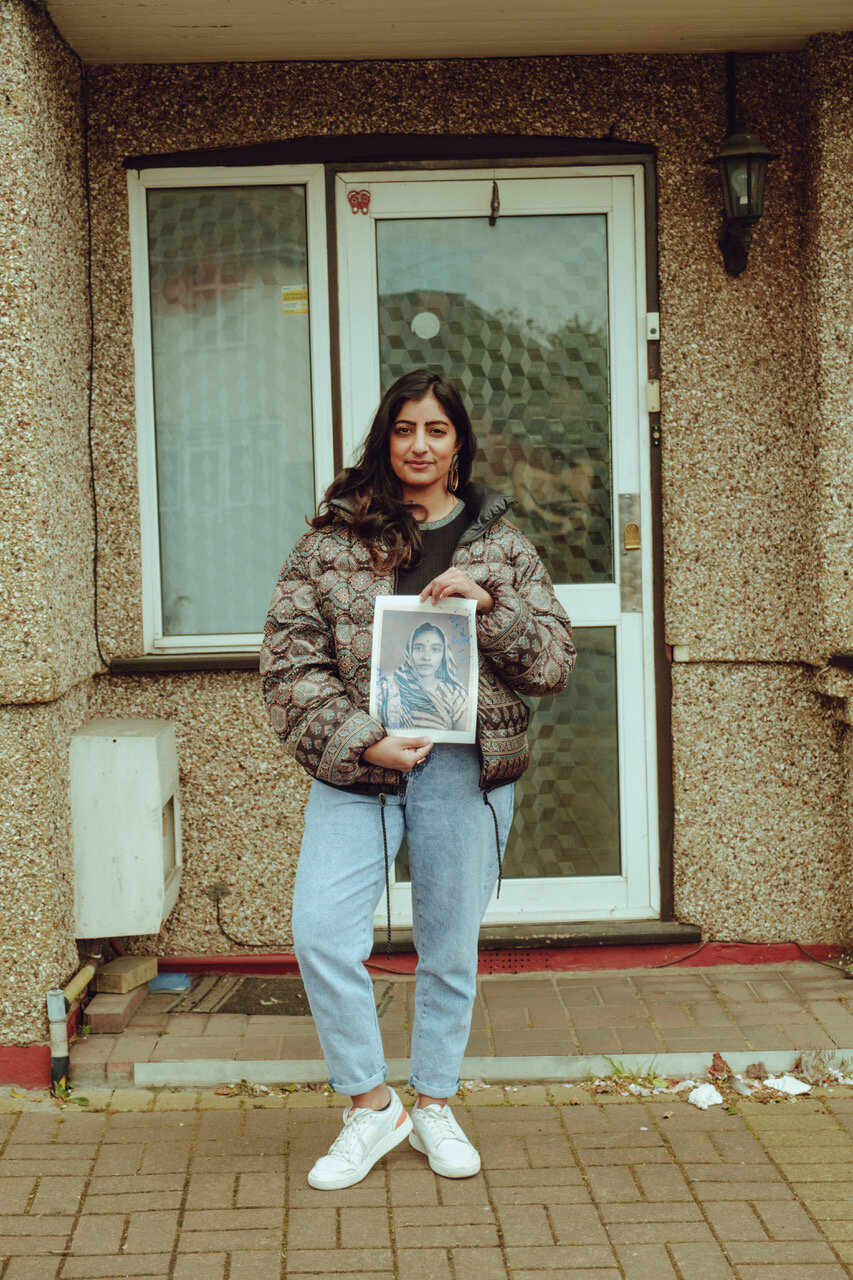Image by Ofilaye.
Delving into the history of gold jewellery in South Asian culture and its unique importance for South Asian women, designer Anisha Parmar reflects on gold as a conduit of family histories and a symbol of female independence
words Anisha Parmar
I often remember going to the temple with my grandmother, surrounded by the roar of collective chanting and clapping. When it was our turn to go to the front to have our darshan (sacred sight), I would stare doe-eyed up at the Idols of Gods and Goddesses, in awe of their dress. However, my eyes were always drawn to their gold jewels—the shape, colours, and how the glow from the gold lit up their faces. My whole life, gold has been synonymous with South Asian culture; it is a constant presence in life's milestones as we celebrate births, weddings and even mark death. Gold is gifted to you at birth by close relatives, worn on your wedding day and gold coins are placed in your coffin before burial. Often a beaming representation of security, wealth, power, and for the most part a given—gold is so ingrained in our culture that we often overlook the importance placed on it, its symbolic history and the unique significance for South Asian women.
In The Grace of Four Moons: Dress, Adornment, and the Body in Modern India, Pravina Shukla, Associate Professor in the Department of Folklore and Ethnomusicology at Indiana University, mentions that ‘ornaments in Hindu mythology, in legends and folktales, signal the power of jewellery to express valour, wealth, generosity, affection, identity and social relationship’. According to Vedic belief, Lord Brahma (The God of creation) was born from a beaming gold egg. Furthermore, in the Upanishads, gold is also seen as a symbol for the soul, malleable in materiality, resilient, and taking many forms.
Image by Ofilaye.
One of these forms is the concept of dowry: a transfer at marriage from parents to daughters and in-laws, and an ancient tradition thought to date back to at least 200BC in medieval western Europe. Although now illegal in India, the concept still lives on and families in India often start saving for the dowry as soon as a girl is born. A 2018 study showed the heartbreaking links between gold prices and the survival rates of baby girls in India—when the global gold price goes up, it is more likely that girls will be aborted or die in the first month of life.
The concept of a dowry is mostly redundant within the South Asian diaspora in the UK. The transference of gifts from the bride’s parents is mostly to the bride herself, as her own financial security and even more common as financial help when buying a home. Until the mid-20th century, the only form of stri-dhana (stri meaning woman and dhana meaning money/property) according to Hindu sastric law was the female’s right to gold, often gifted to her by her parents during her wedding. Patriarchal biases in these laws meant, and often still mean based on interpretation, that an Indian woman’s right to property and financial assets was often limited, thereby placing immense importance on the accumulation of her assets in the form of gold jewellery. Traditionally, gold jewellery pieces were given to the daughter as security if for any reason she had to flee the marital home, as well as the gifts given to in-laws for ‘looking after’ her. This may explain why in my own family there has been such huge importance placed on being financially independent especially as a South Asian woman. Our female ancestors relied so much on their male counterparts (father, brother, husband) that when we, as the first generation who had a chance to study at university, chose career paths, there was a huge premium placed on being financially stable.
I have always seen adornment as a tool of empowerment, a cultural marker and as body armour preparing you for life’s unpredictability.
As my generation became more educated, career-focused and independently secure through our jobs and life choices, the meaning of these jewellery pieces morphed to focus on sentimental value. I have always seen adornment as a tool of empowerment, a cultural marker and as body armour preparing you for life’s unpredictability. Shukla shares this view stating, ‘self-adornment is a powerful vehicle for self-realization, at once subtle and firm. Though men perceive [self-adornment] to be unimportant and non-threatening, it is filled with satisfaction and social consequence. By means of adornment, women gain self-esteem, love, happiness and a psychologically enabling perception of power.’
Growing up in a Gujarati, Indian, Hindu, East African, British amalgamated household, gold was a mainstay—adornment decked our home from statues, idols, gold embellished paintings and ornaments; wherever you looked there was a carefully adorned nook. From weekends going to the gold jewellers with my mum on Ealing Road in Wembley where I grew up to playing with my grandmother’s jewellery, gold is such a norm for us, that we overlook the incredible stories, memories and histories these pieces evoke—especially within the South Asian diaspora in the UK.
Image by Ofilaye.
It was the gold jewellery handed down to me from my Baa (paternal grandmother), that inspired my creative journey running my own jewellery brand. She passed away when I was 12 years old, after suffering a terrible stroke; I was at boarding school in Gujarat in India at the time and I recall my parents flying me back early because she was asking for me. I still remember her saying my name from the hospital bed hours before she passed away, but didn’t realise the significance of my connection to her till much later on in life.
Being the only daughter on my father’s side of the family, I inherited her gold jewellery pieces, which I only saw for the first time properly almost eight years after her death, and that was when everything changed for me. I could feel her through these pieces, they told a story she never had the chance to share with me, of a strong, fearless orphaned woman, married off young, who moved to two countries, raised four sons and lost two daughters. Because of these pieces, I have been back to Varvara, the tiny village in Gujarat that my family came from and while I was there, saw the shack-like home where my ancestors lived and worked as tailors and yet saw the significance in investing in gold. Though the hierarchical caste system that was fully reinforced during the Raj reserved the right of adornment for the higher castes that were deemed ‘closer to God’, for my own family who came from very humble beginnings there had always been an importance placed on gold mainly because gold always held and increased its value.
When I found her first-ever Indian passport and saw Rambha, my Baa, at the tender age of 22 supposedly, (I assume she was 22, because back then no one really kept a record of exact birth dates, so birth dates in passports were always estimated), I saw a bold, powerful and determined woman staring back at me and have felt her guiding me ever since. It was her gold pieces that led me to design jewellery and I find myself piecing together her story through these heirlooms. The frustration is that I never had the chance to ask her about her pieces. My work is born through that frustration, and the need to document more of these stories before they are lost is what drives me.
the meaning of these gold jewellery pieces have changed as they have travelled and been passed down through generations, from dowry, security and now adornments of great sentimental value. These pieces are more than visual beauty, they hold oral histories and stories
Image by Ofilaye.
Over the last six months, with the support from the Arts Council, I have been documenting stories of gold jewellery collected through South Asian journeys of migration as artefacts with the capacity to be carriers of emotions and memories; gold as a woman’s security within the context of historical and contemporary diasporas; and gold as adornment to express cultural heritage. We talk about how the meaning of these gold jewellery pieces have changed as they have travelled and been passed down through generations, from dowry, security and now adornments of great sentimental value. These pieces are more than visual beauty, they hold oral histories and stories of Indian partition, East African Asian migration, Sri Lankan Civil war.
Mathushaa tells me that when her mum left Sri Lanka due to the civil war, one of the few things she brought with her was her ID card. The gold pieces Mathushaa showed me were gifted to her when she was born in the UK after her family moved, and are the only heirlooms in her family since they left their homeland with nothing. For her and her family, gold acts as the most important marker of new births in a safe land. Participant Aysha says, ‘jewellery is a major part of women, it empowered women because it was their one thing, it was their security.’ Another participant, Sofia, recalls desperately wanting a car when she was 18 years old and her dad saying, “well, you can’t wear a car!”. While Tanya speaks about how she feels close to her late mother and feels her energy in the pieces that were handed down, so she wears them every day. In every one of these conversations, the gold jewellery is merely the gateway to conversations of South Asian migration, resilience, success, heartbreak and history. These handcrafted pieces take on the material form of a family’s legacy and accumulate personal stories as they pass through their keepers—keepers which they choose. As Aysha says in our conversation, ‘you don’t choose the jewellery, the jewellery chooses you’.
Passed through the hands of artisans, then worn by our ancestors, and cherished by us today, our gold jewellery transports us to places we have never been to and tells stories we have never heard. We wear them with pride, feeling our ancestors lifting us as we navigate new cultural codes in a land where they brought us better opportunities, in the hopes we can make them proud and carry on their legacy. It is crucial that this British history is not lost.
PROFILE
Anisha Parmar is a globally successful jewellery designer and multi-disciplinary artist whose work is inspired by her family’s journey from Gujarati, East Africa and the U.K. Her latest project, Empowered Adornment: Gold Jewellery stories with Anisha Parmar, will be available to view at Derby Museums on August 6th, 2021. You can also tune into her podcast to her more stories from her research on gold jewellery as carriers of emotions and memories collected through South Asian journeys of migration.




